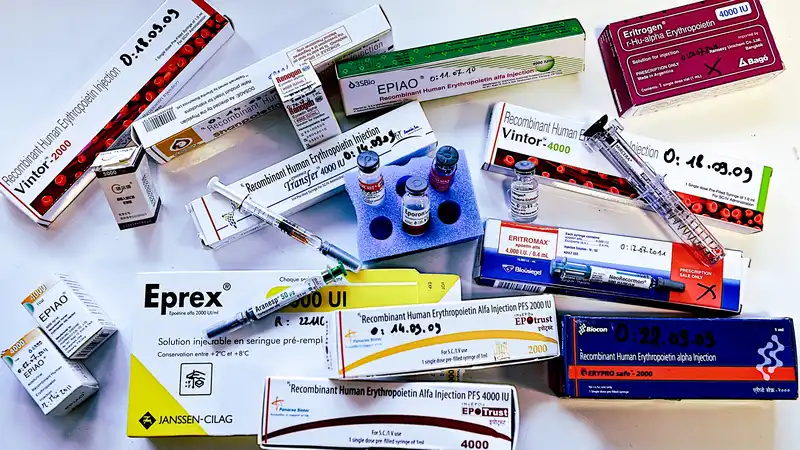It has been 12 years since Lance Armstrong's lifetime ban for doping shook the sport and transformed his once heroic status into pro cycling's most notorious villain. But recent stunning performances by riders like Tadei Pogachar, who broke Armstrong's climbing record in Pula Dade, have rekindled suspicions.
As Mathieu van der Pol broke the Paris-Roubaix speed record and the Milan-San Remo poggio ascent record, and Pogachar broke Marco Pantani's Plateau de Beille ascent record, the level of professional cycling has risen since the EPO-dominated 1990s and 2000s There is no disputing that the level of professional cycling has risen above the EPO-dominated era of the 1990s and 2000s.
Radio France released a report on Friday that delves into the methods riders may be using to improve their performance.
The investigation suggested that some riders may be using a cocktail of legal painkillers, supplements such as ketones, asthma medication, and trace amounts of illegal drugs. It concluded that the tendency to “drug-pack riders” may lower the barrier to anti-doping rule violations.
The two drug cocktails offered by certain teams are referred to as “Bomba” and “Magic Box.” [e.g., a combination of Voltaren (a prescription nonsteroidal anti-inflammatory drug), caffeine, and paracetamol, or, according to another player, a mix of paracetamol, caffeine, the bronchodilator theophylline, and a muscle relaxant called thiocorticoside.
“Riders who wanted it helped themselves. I was curious, but that's not my way of thinking,” the anonymous rider said.
“In any case, it's not the reason some people are climbing the pass three times faster than they were 20 years ago.”
Another report this year by Le Temps raised concerns about the possible use of the powerful opioid painkiller tapentadol in the peloton.
Jean-Pierre Verdy, former head of the French Anti-Doping Agency, said that the drug combination amounted to de facto legal doping.
“All drugs that relieve pain, relax, eliminate cramps, and make recovery as fast as possible. All of these approved products together constitute doping,” Verdi told Radio France.
Riders can also legally take drugs that are not banned by taking advantage of the therapeutic use exemption. While this practice is legal, it can be used to bend the rules and permit the use of some substances that may enhance performance without punishment.
“I noticed that 80% of the athletes in the peloton have asthma and can take Ventolin by TUE. But Ventolin is anabolic when taken in large doses,” Verdi said.
Emmanuel Brunet, performance manager for the French Cycling Federation, is concerned that overuse of the drug risks creating an arms race that could return professional cycling to its drug-addled past.
“This is a major concern for us,” says Brunet. 'One of the most devastating deviant effects is that we're going to see the same thing among young people. We know that the trivialization of drug therapy in the past encouraged doping 20 years ago.”
Riders continue to be under pressure to perform to keep their jobs, a situation exacerbated by the UCI's promotion/relegation system. Points equal a WorldTour ranking and a spot in the Tour de France, which are important to sponsors and key to the team's future.
The use of ketones and carbon monoxide rebreathers adds another layer to the conversation. Ketones are thought to improve recovery, but may also increase EPO production in the body, as does inhalation of carbon monoxide. Both are expensive and the health risks to athletes from their use are unknown.
Radio France reports that even teams that are part of the Movement for Trustworthy Cycling (MPCC), which has recommended a ban on the use of ketones as well as the UCI, which began studying the supplement in 2021, continue to use ketones.
“Like the UCI, the MPCC has from the beginning asked athletes and teams not to use ketones until the studies commissioned by the UCI have been clarified,” Roger Le Gay, president of the organization, told Cycling News.
“This is a precautionary principle, because we don't know if there will be an improvement in performance and what the short- and long-term effects will be.
“We should know the response and recommendations by the end of next year.”
The MPCC successfully lobbied to have tramadol added to the banned list, but a similar campaign against ketones would be difficult without testing for ketone use.
“To date, ketones have not been banned by WADA, and we do not intend to blacklist them unless additional information on their dangers and performance enhancement is provided,” says Legay. Unlike corticosteroids and tramadol, “there is currently no way to detect the use of ketones.
The UCI rejected the possibility of a performance-enhancing effect of carbon monoxide rebreathers, telling Radio France, “The scientific data do not allow us to give a larger effect of carbon monoxide on performance than the one observed after high-altitude training.”
He stated.
Besides these legal options, improvements in equipment such as more aerodynamic bikes and clothing could explain some of the increase in speed, but Brunet still sees gaps in explaining the superior performance of riders such as Pogachar.
“In the World Tour teams, everyone uses more or less the same type of tires, bikes, and clothing. Almost everything is manufactured in the same place. If there is a difference, it is probably genetic,” he added, however, ”when I was riding in the junior and espoir categories, I didn't notice such a difference.”
Pogachar denied the allegations after concluding the 2024 season with his fourth victory at Il Lombardia.
“We now realize that cycling is a really dangerous sport. Like a heart accident, you should never push the limits; if you risk your health for the sake of a 10-year career, it's a waste of life and a stupid thing to do."
..

Comments